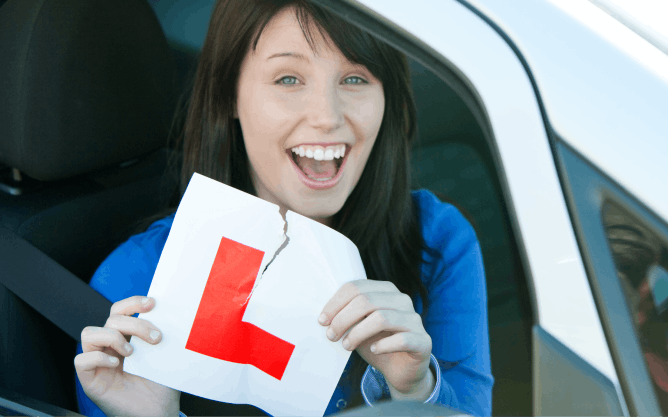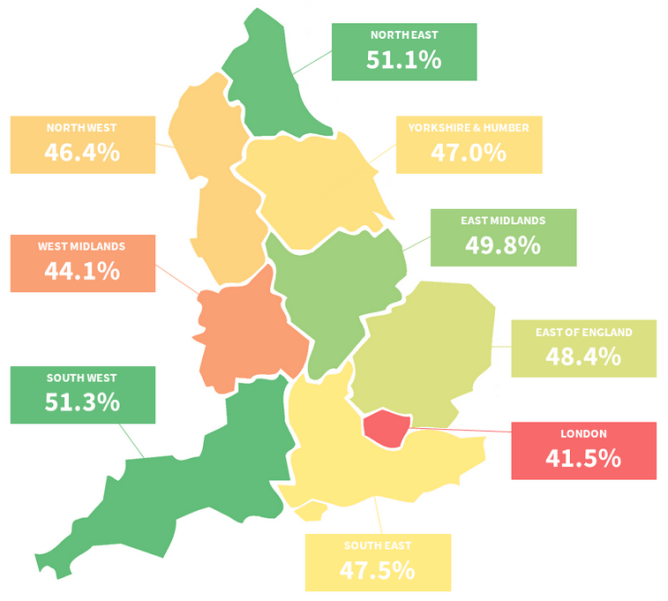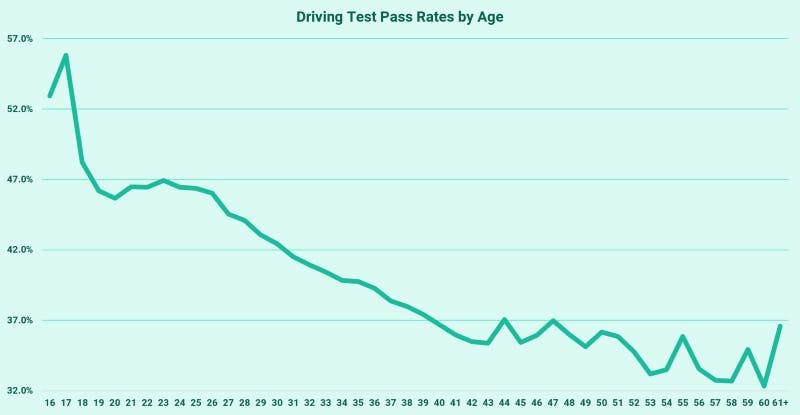Everything You Need to Know: UK Practical Driving Test Pass Rate
January 18, 2024
•6 min read

Sam Plant
Content Writer

Ever since 1903, anyone hoping to get behind the wheel of a car in the UK has needed to have a driving licence. But one thing has remained the same throughout the years: taking the test is still a nerve-wracking experience.
We’re here to ease the nerves. So, we’ve hunted down the stats, facts, and figures to debunk the myths, settling some scores and help you get ready for the big day!
DVSA Driving Test Pass Rates 2021-2022
Between April 2021 and March 2022, the average pass rate across the country came in at 50% — the highest in more than a decade. But it’s not just about the national average; where you take your test can have a big impact on your chances of passing.
Spare a thought for drivers taking their test at the Belvedere test centre in south-east London. In 2015/16, only 30.6% of tests carried out ended with the learner passing. And things were even worse down the road in Erith, unproud holders of the UK’s lowest pass rate — 27.5%.
Once you look at some of the country’s most rural areas, learners’ chances of success fly through the sunroof. The pupils at the Isle of Mull test centre in Scotland smashed it in 2021/22, with 87.5% earning their licence — the best pass rate in the country. The Isle of Mull isn’t a haven of F1 drivers-in-training though; only 8 tests were taken there over the course of the year, so the roads are probably very quiet. You’ve still got to feel for the unlucky learner who didn’t pass, though.
In fact, when it comes to the best pass rates, Scotland dominates the list: 9 out of the top 10 test centres in the UK are Scottish. Meanwhile, the bottom 10 test centres on the list are all in England’s inner cities.
Before any Scottish readers declare themselves the next Lewis Hamilton, it’s worth noting that the overall pass rate for Scotland stands at 48.4% — higher than the average for the UK but lagging behind 4 English regions. Top of the pile, though, is Wales, whose pass rate of 52.4% stands a whopping 5.4% above the national average.
Regional Map of Driving Test Pass Rates in England

Correct as of 2017/18
Because rural roads tend to be quieter and more predictable than urban roads, taking the test can be easier in the countryside than in the city.
A word of caution, though, to anyone hoping to head for the Highlands in hope of passing: learning to drive doesn’t just mean getting your licence — it also means learning how to deal with the situations you’ll encounter on the roads in real life.
While rural learners might find it easier to pass, they won’t have any experience driving in the city. Choosing a test centre close to home means that the driving conditions will be the same as those you’ll actually need to deal with from day-to-day. Passing your test is no good if you’re not going to be able to handle real-life situations on the road, so it’s always best to learn in your local area.
First-time passes: beginners' luck on the driving test?
There’s plenty of pressure on learners to pass first time: to beat your mates, get that job interview, or simply avoid the stress of going through the test all over again.
Plenty of people will brag that it was so easy to pass first time — others keep taking test after test, but never seem to get it right.
The truth is that it’s totally normal not to pass first time around; usually around 40% of learners get their licence in one go. But, since the pandemic, first-time passes has risen to a very decent 51%. The exact reason why, we’ll probably never know.
Average attempts to pass the driving test
If you do happen to hit a snag on your first time, then don’t worry: there are plenty of people in the same boat.
The good news is that if you don’t get it right first time, you’re more likely to pass on your second try: 50.4% of people taking their second test pass, and 48.7% of people on their third attempt get their licence.
One thing is clear: pass rates remain relatively similar for each individual test, showing that what matters is what happens on the test day itself.
It’s also important to remember that the best thing to do is not to give up, and to keep on trying: after all, around half of people pass on their first attempt, but nearly 9/10 will pass within three attempts!
Keep hearing about ‘guaranteed pass’ driving courses?
Truth is, nobody can guarantee the result of your driving test.
But, PassProtect is the closest you’ll get. Add it to your course or fast-tracked test booking and you get 2 fast-tracked retests for the price of 1.
That means you get 3 attempts in total. And remember, 9/10 people pass their test within 3 attempts!
Are men or women more likely to pass their driving test?
We’ve heard all the tropes about male and female drivers over the years — but when it comes down to actually passing, which gender comes out on top?
As of 2021/22, male drivers are slightly more likely to pass, with just over half of all tests taken by men resulting in a pass (52.6%). Meanwhile, 48.2% of tests taken by female drivers resulted in a pass.
There’s good news for both genders, though. Since 2007/8, pass rates have increased by 5% (males) and 7% (females), with nearly 350,000 new drivers getting their licence in 2021/22 despite the DVSA conducting fewer tests due to covid restrictions.
Youth vs experience
Now that we’ve sorted out the battle of the sexes, we move onto the next big competition: are older drivers really better than younger drivers?
It’s certainly true that a driver with years of experience on the road is likely to be better prepared to deal with a wide range of situations than someone who’s just got rid of their ‘L’ plates.
When it comes to actually passing your test, however, younger drivers are streets ahead.
Pass Rates by Age

As you can see from the above graph, the youngest drivers of all—17-year-olds, as well as the small handful of 16-year-olds allowed to take their test early—have some of the highest pass rates in the country.
Intriguingly, the pass rate then sharply dips — 18-year-olds are less likely to pass than 17-year-olds, with the trend suggesting that the older you are, the slimmer your chances of passing.
If you are a mature learner, don’t be discouraged! You’re never too old to get behind the wheel — meet Miriam, a 66-year-old lady who is learning to drive with PassMeFast (and loving it).
And we’ll never forget Richard Hargreaves who passed his test aged 70 — age really is no limit.
Surprising stats
There are plenty of other surprises to be found when searching through the vast amounts of driving test data.
Did you know that the pass rate for first-timers is usually higher than the overall pass rate? In 2021/22, 52.6% of people taking their test for the first time passed — compared to an overall pass rate of 50.5%.
Another myth to debunk is that it’s easier to pass your test in an automatic car. In fact, the pass rate for tests in automatic cars was 38.9% in 2017/18, 8.2% lower than the manual pass rate for that year. This doesn’t mean automatic cars are necessarily harder to drive, though. It could be that people who choose auto are less confident drivers, more likely to live in a city, or one of many other reasons!
Improving your chances of passing your driving test
Pass rates can vary dramatically for so many different factors — so it’s no wonder that many people are worried about taking their test.
Learning with PassMeFast is different.
Instead of old-fashioned driving lessons spread out over months (or even longer), PassMeFast specialises in intensive and semi-intensive courses where you can learn to drive in a matter of days.
Instead of waiting around and needing to refresh what you’ve covered in your previous lessons, you’re constantly building up your knowledge and confidence, ensuring you’re ready for your test.
Better still, PassMeFast offer fast-track practical tests so you could take your theory and practical driving test weeks, or possibly even months, ahead of standard DVSA waiting times.
We evaluate every member of our team of DVSA-approved driving instructors so you can pass fast without compromising teaching quality.
To top it all off, we have a tonne of online resources covering every aspect of learning to drive.
P.S. Don’t forget to add PassProtect to your booking to give yourself the best chance of passing. If your first test doesn’t go to plan, you’ll get 2 more fast-tracked tests for the price of 1.
Not sat your theory test yet? You can't book your practical driving test until you've passed the theory test — find the latest theory test pass rates here
Subscribe for driving advice, offers & more
We'd love to let you know about our courses, news and offers via email. You may unsubscribe at any time.
Star Genie Limited trading as PassMeFast. Company number 10093359
Copyright © 2024 owned by Star Genie Limited
PassMeFast, Blue Tower, MediaCityUK, Salford, M50 2ST
